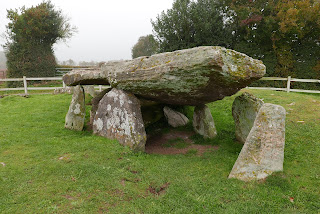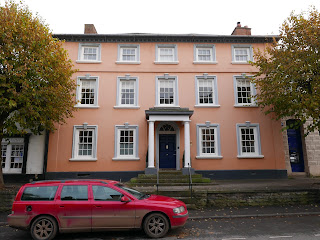And yet it isn't in England. The name suggests that the town is English, albeit clearly on a river that forms the Welsh Border here and there in this general region. But Hay is in fact in Wales, though only just. It has a Welsh name, Y Gelli Gandryll, which my rough knowledge of Welsh tells me means 'The Devastated Wood'. It's odd that it isn't actually named Y Gaer Gandryll, meaning 'The Ruined Castle', for there is just such a castle overlooking the town:
Here are less fanciful photos of it:
Castles are thick on the ground all along the Welsh Border, from north to south. In turbulent times they were an essential refuge; often they were strategic strongholds from which the Border could be watched and raids mounted. Hay isn't at all unusual for having one.
As soon as you leave the town going eastwards you enter England. It's that close. So the place has a hybrid feel, a cross-border culture, and is not like the places deeper into Wales, less influenced by English ways and English laws. This diluted Welshness is accentuated because of the famous Hay Festival, held every year in early summer - a music and philosophy gathering, as well as a magnet for book-lovers - which creates an international atmosphere that lingers on for the rest of the year. The town actually has links with Timbuktu in Mali, West Africa. A plaque in the main car park proudly says so:
How these two places twinned together is a mystery! I'm guessing that a West African author was a guest at the literary festival sometime since it began nearly thirty years ago, and his or her influence created the connection. Or possibly it was a West African musician or band. Be that as it may, a carefully-chosen delegation of local Hay councillors must fly off to Timbuktu each year - braving the swords of the savage Tuareg - to keep the twin towns' mutual regard simmering. And, similarly, a carefully-chosen delegation of Timbuktu elders must arrive at Hay each year - braving the savage loss of their baggage at London Heathrow, and the risk of catching a cold - to maintain this presumably fertile cross-cultural symbiosis.
Hay and Timbuktu...so far as I am aware, Newhaven is the only Sussex town to boast an equally remarkable exotic link. Newhaven celebrates a connection with Ho Chi Minh. (See my post Ho Chi Minh on 29th July 2014)
I didn't know about the Timbuktu connection (nor much else about the town) when I visited Hay on a cool and largely sunless afternoon in late October. I'd seen the Mappa Mundi at Hereford in the morning, and had then studied the map (the Ordnance Survey map, I mean, not the Mappa Mundi!) to find out what I could fit in before sunset. Ah, I said to myself, I could do three things. First: inspect a prehistorical burial chamber called Arthur's Stone, high up in the hills north-west of Hereford. Second: visit Hay. Then third: coax Fiona over the high and exposed Gospel Pass in the Black Mountains, which would take me past Llanthony Priory on the other side.
Arthur's Stone was on a minor road, and not very easy to find. It was very much a leap of faith to whizz Fiona ever upwards along twisting lanes with blind corners, trusting that no car or tractor was coming the other way. We survived. It was worth the effort. Sort of. Some burial chambers are just a pile of old stones, but this one (though it had completely lost its original covering of earth) was more complete than most, and featured a very large capstone supported by smaller ones. A bit like some of the Cornish quoits:
I was rapidly sated. I soon left the misty uplands to cruise down into Hay.
Frankly, the town was a little disappointing. I wasn't coming to it in the best of weather, nor during the busy and vibrant Festival, when it might be expected to be buzzing. To be sure, the large - overlarge - car park was bursting with cars, implying that the town, even in late October, might be seething with visitors. But something told me they would be casual afternoon tourists, and not serious bibliophiles. It didn't help that tackiness in the form of luridly-painted gift shops hit you even before you got far from the unromantic car park. Study this shot, for example:
But I persevered. And in truth the centre of the town, when I reached it, did have streets lined with an unusual number of proper bookshops - of the kind I'd been hoping for. But where were the crowds?
I went into several bookshops to browse, but failed to see anything to part me from the pennies in my purse. And the crowds, wherever they were, were not in the shops, thumbing through the books on the shelves. There was no frenzy anywhere. You could hardly say there was any atmosphere at all.
I was however much interested in capturing the mood and character of the town in pictures, and despite the dull weather, I think I got its measure. This was no Portmeirion, but there were still plenty of architectural subjects.
The town centre, surely the main focal point at Festival-time, was in fact quite small in extent, and consisted of a tight maze of narrow streets, some pedestrianised, some not. Crowded, these streets would of course come alive. As it was, it all felt terribly end-of-season. You'll have noticed that restaurants, upmarket gift shops, country clothing shops, and posh provision shops abounded. Perhaps most of the visitors were in those?
The best view I found in Hay was down at the river. The Wye looked pretty good from the road bridge.
The road bridge had these unusual stumps at the edge of the footway, clearly designed to trip up pedestrians and make them take a header into the oncoming traffic:
They were of course meant to deter parking on the bridge, double yellow lines not being sufficient. At the town end of the bridge was this bilingual Welsh-English advertisement for an investment in wind farming, which was one of the few things I saw that reminded me of Hay's geographical position inside Wales:
I came here partly to see what all the fuss was about, why so many people speak of Hay-on-Wye in tones of deep respect and awe, and rave about the Festival. I'd attended the Appledore Book Festival in North Devon since 2012, and had found it very enjoyable. So I was curious to know what extra things Hay had, that made it the book festival to go to.
But frankly I couldn't see them. Yes, Hay had a pleasant riverside location; it had more places to eat than Appledore had, and a much larger car park; probably it had more places to stay; and it might well possess more suitable places to hear speakers, attend workshops, and enjoy other kinds of event. It certainly had an abnormal number of good bookshops, whereas Appledore now had none at all. And yet, to my own mind, Hay lacked charm. It was not especially picturesque. And it certainly didn't have the invigorating sea air that Appledore enjoyed.
I entered these five pictures below for a photo competition earlier this year, run by the Appledore Visitor Association. They will have chosen the winner by now. I'm afraid that no congratulatory email has come - my entries were just not good enough. But I still think they showed scenes perfectly characteristic of Appledore, exactly the kind of thing any visitor to the the Appledore Book Festival would see. Hay has nothing like this:
Perhaps I am being unfair, comparing sunny summer shots with cloudy late autumn ones, a maritime location with an inland one, and Appledore's two-week event with Hay's year-round programme of cultural happenings. But I don't think I'll be making a special effort to visit Hay again, not unless I'm already in the area and there's a particular book I want to find.





































